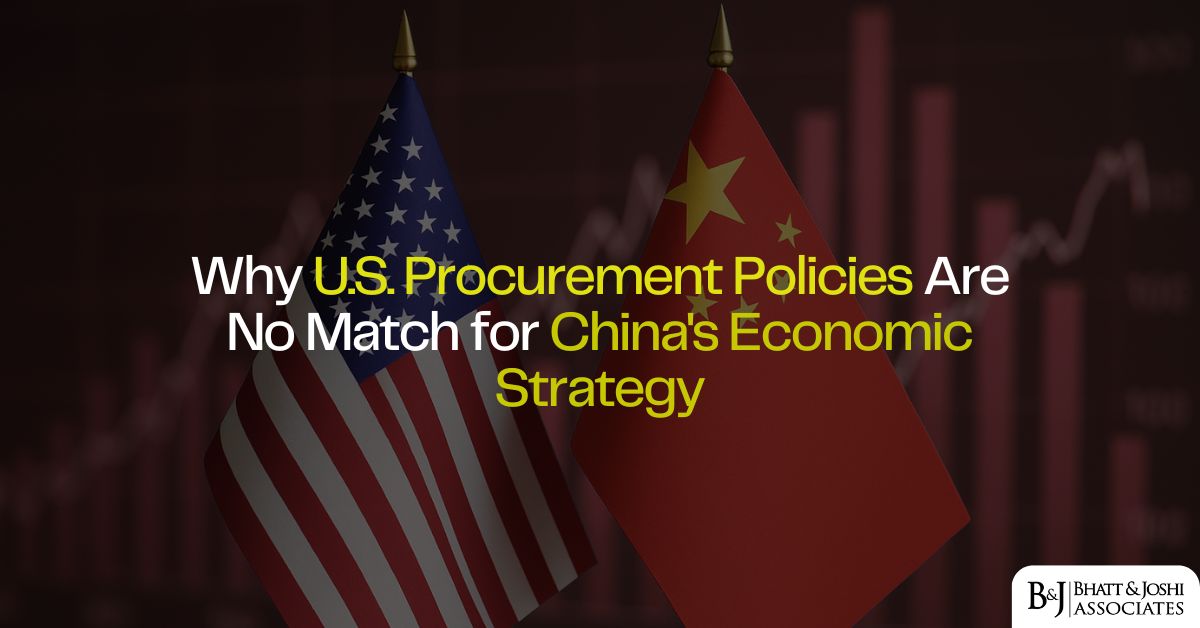Introduction
Government procurement, representing over $13 trillion in annual spending globally, serves as a crucial tool for economic development and industrial policy. The stark contrast between China’s coordinated, strategic approach to procurement and America’s fragmented, regulation-bound system illustrates fundamental differences in how these nations view the role of state purchasing power in economic development. While the United States primarily treats procurement as an administrative function focused on cost efficiency and process transparency, China leverages it as a strategic instrument for industrial development and technological advancement. This divergence in approaches has significant implications for economic competitiveness, technological innovation, and industrial capacity. Understanding these differences is crucial for policymakers seeking to address the challenges within U.S. procurement policies, particularly in relation to declining industrial competitiveness and technological leadership.
The Strategic Role of Government Procurement
Government procurement extends far beyond simple purchasing decisions. It shapes markets, drives innovation, and determines the viability of entire industries. Through procurement policies, governments can create assured markets for emerging technologies, support strategic industries, and influence technological standards. The scale of government purchasing—typically 10-15% of GDP in developed economies—makes it a powerful tool for economic development.
In today’s global economy, procurement policies play an increasingly critical role in technological competition and industrial development. Countries that effectively leverage government purchasing power can accelerate innovation, build industrial capabilities, and create competitive advantages in strategic sectors.
China’s Strategic Procurement System
China’s procurement system operates as an integral part of its broader economic strategy. The Chinese government explicitly uses procurement to advance national objectives, including technological development, industrial capacity building, and economic self-sufficiency. This approach is characterized by several key elements:
Under China’s system, procurement decisions align closely with national industrial policies like Made in China 2025. State purchasers prioritize domestic suppliers in strategic sectors, creating guaranteed markets for Chinese companies developing new technologies or capabilities. This approach has proved particularly effective in emerging industries like electric vehicles, renewable energy, and artificial intelligence.
The centralized nature of China’s system allows for rapid mobilization of resources and coordinated action across different levels of government. When China identifies a strategic priority—whether in semiconductors, electric vehicles, or telecommunications—procurement policies quickly align to support development in these sectors.
U.S. Procurement Framework
The U.S. procurement policies, by contrast, are governed by a complex web of regulations and competing priorities. The Federal Acquisition Regulation (FAR) system, while designed to ensure fairness and prevent corruption, often creates barriers to strategic purchasing decisions. Multiple agencies with different priorities and requirements fragment procurement authority, making it difficult to implement coordinated industrial policies.
Buy American provisions and similar requirements, while intended to support domestic industry, often prove inflexible and ineffective. The system’s focus on short-term cost savings and procedural compliance can work against longer-term strategic objectives like building domestic industrial capabilities or supporting emerging technologies.
Comparative Outcomes of Procurement Systems: China vs. U.S.
The divergent approaches to procurement have produced markedly different results. China has successfully used procurement to build world-leading positions in industries like solar panels, electric vehicle batteries, and 5G telecommunications equipment. These successes often build directly on government procurement support during early market development.
The U.S. system, while promoting competition and transparency, has struggled to support strategic industrial development effectively. American companies often face uncertainty about government demand, making it harder to invest in new capabilities or technologies. This has contributed to the erosion of domestic manufacturing capabilities in several critical sectors.
Strategic Industry Development
China’s procurement system demonstrates particular strength in supporting strategic industry development. When Chinese policymakers identify a priority sector, they can quickly mobilize government purchasing power to create markets and support domestic producers. This approach has proved especially effective in emerging technologies where early market support is crucial for development.
The U.S. system, despite various “Buy American” provisions and small business set-asides, lacks similar strategic coherence. Multiple agencies with different procurement rules and priorities make it difficult to implement coordinated industrial development strategies. The focus on competition and short-term cost savings can work against longer-term strategic objectives.
Innovation and Technology
The impact of procurement policies on innovation highlights another key difference between the two systems. China’s approach actively uses government purchasing to support technological development, creating markets for new products and technologies even before they are commercially viable. This reduces risk for Chinese companies investing in innovation and helps accelerate technology development.
U.S. procurement policies, while supporting innovation through programs like SBIR (Small Business Innovation Research), often lack the scale and consistency needed to drive technological development effectively. The fragmented nature of the American system makes it harder to coordinate support for emerging technologies across different agencies and programs.
Challenges Ahead for China-U.S Procurement Systems
Both systems face significant challenges moving forward. China’s procurement system, while effective at mobilizing resources, can lead to inefficiencies and overcapacity in some sectors. The emphasis on domestic suppliers may also reduce access to global innovation and expertise.
The U.S. system must find ways to maintain transparency and fairness while becoming more strategically effective. This includes developing better mechanisms for supporting critical industries and emerging technologies without sacrificing the benefits of competition and innovation.
Recommendations for Improving U.S. Procurement
Improving U.S. Procurement policies effectiveness requires several key reforms:
First, Congress should create mechanisms for coordinated procurement strategies in critical sectors, allowing for more effective support of strategic industries and technologies. This could include establishing a central authority to coordinate procurement policies across agencies in strategic sectors.
Second, procurement regulations should be modified to better balance competing priorities—maintaining transparency and fairness while enabling more strategic purchasing decisions. This might include creating special provisions for strategic technology procurement or expanding existing authorities for national security-related purchases.
Third, the U.S. needs better mechanisms for long-term procurement planning in strategic sectors. This would help companies make investment decisions and support the development of domestic industrial capabilities.
Conclusion
The contrast between Chinese and U.S procurement policies reflects deeper differences in how these nations approach economic development and industrial policy. China’s strategic, coordinated approach has proved more effective at supporting industrial development and technological advancement in targeted sectors. However, this comes with trade-offs in terms of market efficiency and innovation.
The United States does not need to—and should not—simply copy China’s procurement system. However, it must find ways to make its procurement policies more strategically effective while maintaining core values of transparency and fair competition. This will require significant reforms to current procedures and thinking about how government purchasing power can support national economic objectives.
Success in this effort will require careful balance between competing priorities—maintaining the benefits of market competition while enabling more strategic use of government procurement to support critical industries and technologies. The stakes in this effort are high, as procurement policy increasingly influences national economic security and technological leadership.














